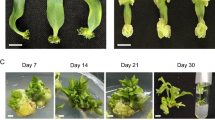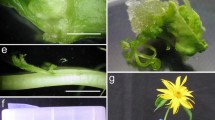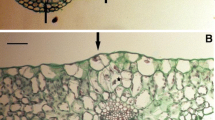Abstract
Regeneration of new shoots in plant tissue culture is often associated with appearance of abnormally shaped leaves. We used the adventitious shoot regeneration response induced by decapitation (removal of all preformed shoot apical meristems, leaving a single cotyledon) of greenhouse-grown cotyledon-stage seedlings to test the hypothesis that such abnormal leaf formation is a normal regeneration progression following wounding and is not conditioned by tissue culture. To understand why shoot regeneration starts with defective organogenesis, the regeneration response was characterized by morphology and scanning electron and light microscopy in decapitated cotyledon-stage Cucurbita pepo seedlings. Several leaf primordia were observed to regenerate prior to differentiation of a de novo shoot apical meristem from dividing cells on the wound surface. Early regenerating primordia have a greatly distorted structure with dramatically altered dorsoventrality. Aberrant leaf morphogenesis in C. pepo gradually disappears as leaves eventually originate from a de novo adventitious shoot apical meristem, recovering normal phyllotaxis. Similarly, following comparable decapitation of seedlings from a number of families (Chenopodiaceae, Compositae, Convolvulaceae, Cucurbitaceae, Cruciferae, Fabaceae, Malvaceae, Papaveraceae, and Solanaceae) of several dicotyledonous clades (Ranunculales, Caryophyllales, Asterids, and Rosids), stems are regenerated bearing abnormal leaves; the normal leaf shape is gradually recovered. Some of the transient leaf developmental defects observed are similar to responses to mutations in leaf shape or shoot apical meristem function. Many species temporarily express this leaf development pathway, which is manifest in exceptional circumstances such as during recovery from excision of all preformed shoot meristems of a seedling.







Similar content being viewed by others
References
Adams J. Adventitious shoots on hypocotyl of flax and tomato. Bot Gaz 78: 461–462; 1924.
Aida M.; Ishida T.; Tasaka M. Shoot apical meristem and cotyledon formation during Arabidopsis embryogenesis: interaction among the CUP-SHAPED COTYLEDON and SHOOT MERISTEMLESS genes. Development 126: 1563–1570; 1999.
Amutha S.; Muruganantham M.; Ganapathi A. Thidiazuron-induced high-frequency axillary and adventitious shoot regeneration in Vigna radiata (L.) Wilczek. In Vitro Cell Dev Biol Plant 42: 26–30; 2006.
Ananthakrishnan G.; Xia X.; Elman C.; Singer S.; Paris H.; Gal-On A.; Gaba V. Shoot production in squash (Cucurbita pepo) by in vitro organogenesis. Plant Cell Rep 21: 739–746; 2003.
Bain H. F. Origin of adventitious shoots in decapitated cranberry seedlings. Bot Gaz 101: 872–880; 1940.
Barton M. K.; Poethig R. S. Formation of the shoot apical meristem in Arabidopsis thaliana: an analysis of development in the wild type and in the shoot meristemless mutant. Development 119: 823–831; 1993.
Black M.; Shuttleworth J. E. The role of cotyledons in the photocontrol of hypocotyl extension in Cucumis sativus L. Planta 117: 57–66; 1974.
Bowes B. G. Polar regeneration in excised roots of Taraxacum officinale weber: a light and electron microscopic study. Ann Bot 40: 423–432; 1976.
Byrne M. E.; Barley R.; Curtis M.; Arroyo J. M.; Dunham M.; Hudson A.; Martienssen R. A. Asymmetric leaves 1 mediates leaf patterning and stem cell function in Arabidopsis. Nature 408: 967–971; 2000.
Costerus J. C.; Smith J. J. Studies in tropical teratology. Ann Jard Bot 13: 97–118; 1896.
Cutter E. G. Plant anatomy. Part II. Organs. Edward Arnold, London; 1971.
Emory J. F.; Floyd S. K.; Alvarez J.; Eshed Y.; Hawker N. P.; Izhaki A.; Baum S. F.; Bowman J. L. Radial patterning of Arabidopsis shoots by class III HD-ZIP and KANDI genes. Curr Biol 13: 1768–1774; 2003.
Esau K. E. Anatomy of seed plants. Wiley, New York; 1960.
Eshed Y.; Schwab R.; Carrington J. C.; Weigel D. Establishment of polarity in lateral organs of Arabidopsis. Curr Biol 11: 1251–1260; 2001.
Gaba V.; Black M.; Canaani O.; Attridge T. H. Photocontrol of hypocotyl elongation in light-grown Cucumis sativus L. Photosynthetic requirement for a fluence rate dependent phytochrome response. Photochem Photobiol 53: 399–405; 1991.
Gaba V.; Schlarman E.; Elman C.; Sagee O.; Watad A. A.; Gray D. J. In vitro studies on the anatomy and morphology of bud regeneration in melon cotyledons. In Vitro Cell Dev Biol Plant 35: 1–7; 1999.
Hus H. Fasciations of known causation. Amer Nat 42: 81–97; 1908.
Huetteman C. A.; Preece J. E. Thidiazuron: a potent cytokinin for woody plant tissue culture. Plant Cell Tiss Organ Cult 33: 105–119; 1993.
Kamenetsky R.; Rabinowitch H. D. Floral development in bolting garlic. Sex Plant Reprod 13: 235–241; 2001.
Keller T.; Abbott J.; Moritz T.; Doerner P. Arabidopsis REGULATOR OF AXILLARY MERISTEMS1 controls a leaf axil stem cell niche and modulates vegetative development. Plant Cell 18: 598–611; 2006.
Kitin P.; Iliev I.; Scaltsoyiannes A.; Nellas C.; Rubos A.; Funada R. A comparative histological study between normal and fasciated shoots of Prunus avium generated in vitro. Plant Cell Tiss Organ Cult 82: 141–150; 2005.
Kuzoff R. K.; Gasser C. S. Recent progress in reconstructing angiosperm phylogeny. Trends Plant Sci 8: 330–335; 2000.
Lamotte C. E.; Curry T. M.; Palmer R. D.; Alberstsen M. C. Developmental anatomy and morphology of fasciation in soybean (Glycine max). Bot Gaz 149: 398–407; 1988.
Laufs P.; Peaucelle A.; Morin H.; Traas J. MicroRNA regulation of the CUC genes is required for boundary size control in Arabidopsis meristems. Development 131: 4311–4322; 2004.
Lurie S.; Zhou H. W.; Lers A.; Sonego L.; Alexandrov S.; Shomer I. Study of pectin esterase and changes in pectin methylation during normal and abnormal peach ripening. Physiol Plant 119: 287–294; 2003.
Masters M. T. Vegetable teratology, an account of the principle deviations from the usual construction of plants. Robert Hardwicke (Ray Society), London; 1869.
McConnell J. R.; Barton M. K. Effect of mutations in the PINHEAD gene of Arabidopsis on the formation of shoot apical meristems. Dev Genet 16: 358–366; 1995.
Mendel K. A case of regeneration of the growing point at the hypocotyl. Palest J Bot Rehovot Ser 2: 89–92; 1938.
Naylor E. The proliferation of dandelions from roots. Bull Torrey Bot Club 68: 351–358; 1941.
Norberg M.; Holmlund M.; Nilsson O. The BLADE ON PETIOLE genes act redundantly to control the growth and development of lateral organs. Development 132: 2203–2213; 2005.
Padmanabhan K.; Cantliffe D. J.; Harrell R. C.; McConnell D. B. A comparison of shoot-forming and non-shoot-forming somatic embryos of sweet potato [Ipomea batatas (L.) Lam.] using computer vision histological analysis. Plant Cell Rep 17: 685–692; 1998.
Palatnik J. F.; Allen E.; Wu X.; Schommer C.; Baum S. F.; Perea J. V.; Bowman J. L. Control of leaf development by microRNAs. Nature 425: 257–263; 2003.
Poethig R. S. Leaf morphogenesis in flowering plants. Plant Cell 9: 1077–1087; 1997.
Pozueta-Romero J.; Houlne G.; Canas L.; Schantz R.; Chamarro J. Enhanced regeneration of tomato and pepper seedling explants for Agrobacterium-mediated transformation. Plant Cell Tiss Organ Cult 67: 173–180; 2001.
Ramage C. M.; Williams R. R. Cytokinin-induced abnormal shoot organogenesis is associated with elevated Knotted1-type homeobox gene expression in tobacco. Plant Cell Rep 22: 919–924; 2004.
Sachs J (1859) Physiologische Versuche uber die Keimung der Schminkbohne (Phaseolus multiflorus). Sitzungsber. d. k .k. Akad. d. Wiss. in Wein 37:57
Sachs T. Regeneration experiments on the determination of the form of leaves. Isr J Botan 18: 21–30; 1969.
Sattler R.; Maier U. Development of epiphyllous appendages of Begonia hispida var. cucullifera—implications for comparative morphology. Can J Bot 55: 411–425; 1977.
Selker J. M. L.; Lyndon R. F. Leaf initiation and de novo pattern formation in the absence of an apical meristem and pre-existing patterned leaves in watercress (Nasturtium officinale) axillary explants. Can J Bot 74: 625–641; 1996.
Shomer I.; Kaaber L. Intercellular adhesion strengthening as studied through stimulated stress by organic acid molecules in potato (Solanum tuberosum L.) tuber parenchyma. Biomacromolecules 7: 2971–2982; 2006.
Snow M.; Snow R. The dorsiventrality of leaf primordia. New Phytol 58: 188–207; 1959.
Steinitz B.; Amitay A.; Gaba V.; Tabib Y.; Keller M.; Levin I. A simple plant regeneration-ability assay in a range of Lycopersicon species. Plant Cell Tiss Organ Cult 84: 269–278; 2006.
Steinitz B.; Küsek M.; Tabib Y.; Paran I.; Zelcer A. Pepper (Capsicum annuum L.) regenerants obtained by direct somatic embryogenesis fail to develop a shoot. In Vitro Cell Dev Biol Plant 39: 296–303; 2003.
Sussex I. M. Morphogenesis in Solanum tuberosum L.: experimental investigation of leaf dorsiventrality and orientation in the juvenile shoot. Phytomorphol 5: 286–300; 1955.
Treml B. S.; Winderl S.; Radykewicz R.; Herz M.; Schweizer G.; Hutzler P.; Glawischnig E.; Ruiz R. A. T. The gene ENHANCER OF PINOID controls cotyledon development in the Arabidopsis embryo. Development 132: 4063–4074; 2005.
Venverloo C. J. The formation of adventitious organs. I. Cytokinin-induced formation of leaves and shoots in callus cultures of Populus nigra L. ‘Italica’. Acta Bot Neerl 22: 390–398; 1973.
White O. E. Fasciation. Bot Rev 14: 319–358; 1948.
Wolf D.; Matzevitch T.; Steinitz B.; Zelcer A. Why is it difficult to obtain transgenic pepper plants? Acta Hortic 560: 229–233; 2001.
Acknowledgments
Contribution from the Agricultural Research Organization, The Volcani Center, Bet Dagan, Israel, No. 506/06. This work was partially supported by a Research Grant from the Ministry of Agriculture and Rural Development, Israel, to V.G. K. Kathiravan received a BOYSCAST Fellowship from the Ministry of Science and Technology, Government of India. S.A. was supported by the MASHAV program of the Ministry of Foreign Affairs, Israel. The authors thank Dr. Moshe Lapidot, ARO Volcani Center, for the use of greenhouse facilities and Naomi Bahat, EM Unit, Faculty of Agriculture, the Hebrew University of Jerusalem, Rehovot, for skilled technical assistance. The authors thank Prof. Simcha Lev-Yadun for critical comments on the ms.
Author information
Authors and Affiliations
Corresponding author
Additional information
Editor: D. T. Tomes
Rights and permissions
About this article
Cite this article
Amutha, S., Kathiravan, K., Singer, S. et al. Adventitious shoot formation in decapitated dicotyledonous seedlings starts with regeneration of abnormal leaves from cells not located in a shoot apical meristem. In Vitro Cell.Dev.Biol.-Plant 45, 758–768 (2009). https://doi.org/10.1007/s11627-009-9232-8
Received:
Accepted:
Published:
Issue Date:
DOI: https://doi.org/10.1007/s11627-009-9232-8




